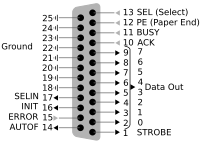Parallel port

A DB-25 connector often used for a parallel printer port on IBM PC compatible computers, with the printer icon.
|
|||
| Type | Point-to-point | ||
|---|---|---|---|
| Designer | Centronics, IBM | ||
| Designed | 1970-1981 | ||
| Manufacturer | Centronics, Dataproducts, Intel, IBM, Compaq, Nortel, etc | ||
| Superseded by | USB (1996) | ||
| Length | 2.3 cm (0.91 in) | ||
| Hot pluggable | Usually not | ||
| External | Yes | ||
| Cable | Usually up to 25 wires including ground; optionally shielded | ||
| Pins | 8 data, 4 output control, 5 input control, 8 ground | ||
| Connector | DB-25, DB25F, "Centronics" 36-pin Amphenol, DC-37, others | ||
| Signal | 0 to +5.0 volt DC | ||
| Max. voltage | 5 volts DC | ||
| Data signal | Parallel | ||
| Width | Variable | ||
| Bitrate |
PP: 150 kbit/s, EPP: 2 MB/s ECP: 2.5 MB/s |
||
| Max. devices | 2 | ||
| Protocol | Application dependent | ||
 |
|||
| IBM PC-compatible parallel port pinout | |||
A parallel port is a type of interface found on computers (personal and otherwise) for connecting peripherals. The name refers to the way the data is sent; parallel ports send multiple bits of data at once, in parallel communication, as opposed to serial interfaces that send bits one at a time. To do this, parallel ports require multiple data lines in their cables and port connectors, and tend to be larger than contemporary serial ports which only require one data line.
There are many types of parallel ports, but the term has become most closely associated with the printer port or Centronics port found on most personal computers from the 1970s through the 2000s. It was an industry de facto standard for many years, and was finally standardized as IEEE 1284 in the late 1990s, which defined the Enhanced Parallel Port (EPP) and Extended Capability Port (ECP) bi-directional versions. Today, the parallel port interface is virtually non-existent because of the rise of Universal Serial Bus (USB) devices, along with network printing using Ethernet and Wi-Fi connected printers.
The parallel port interface was originally known as the Parallel Printer Adapter on IBM PC-compatible computers. It was primarily designed to operate printers that used IBM's 8-bit extended ASCII character set to print text, but could also be used to adapt other peripherals. Graphical printers, along with a host of other devices, have been designed to communicate with the system.
...
Wikipedia
